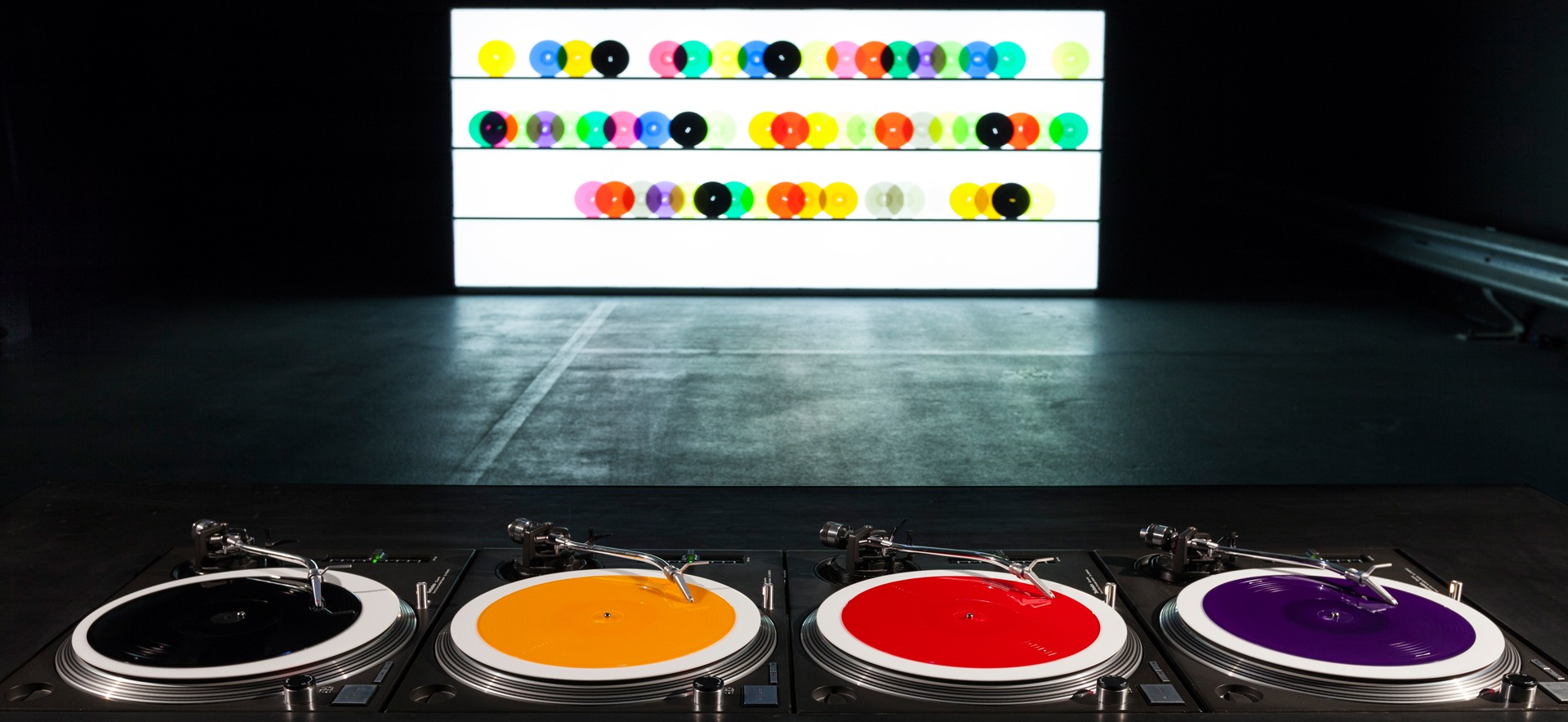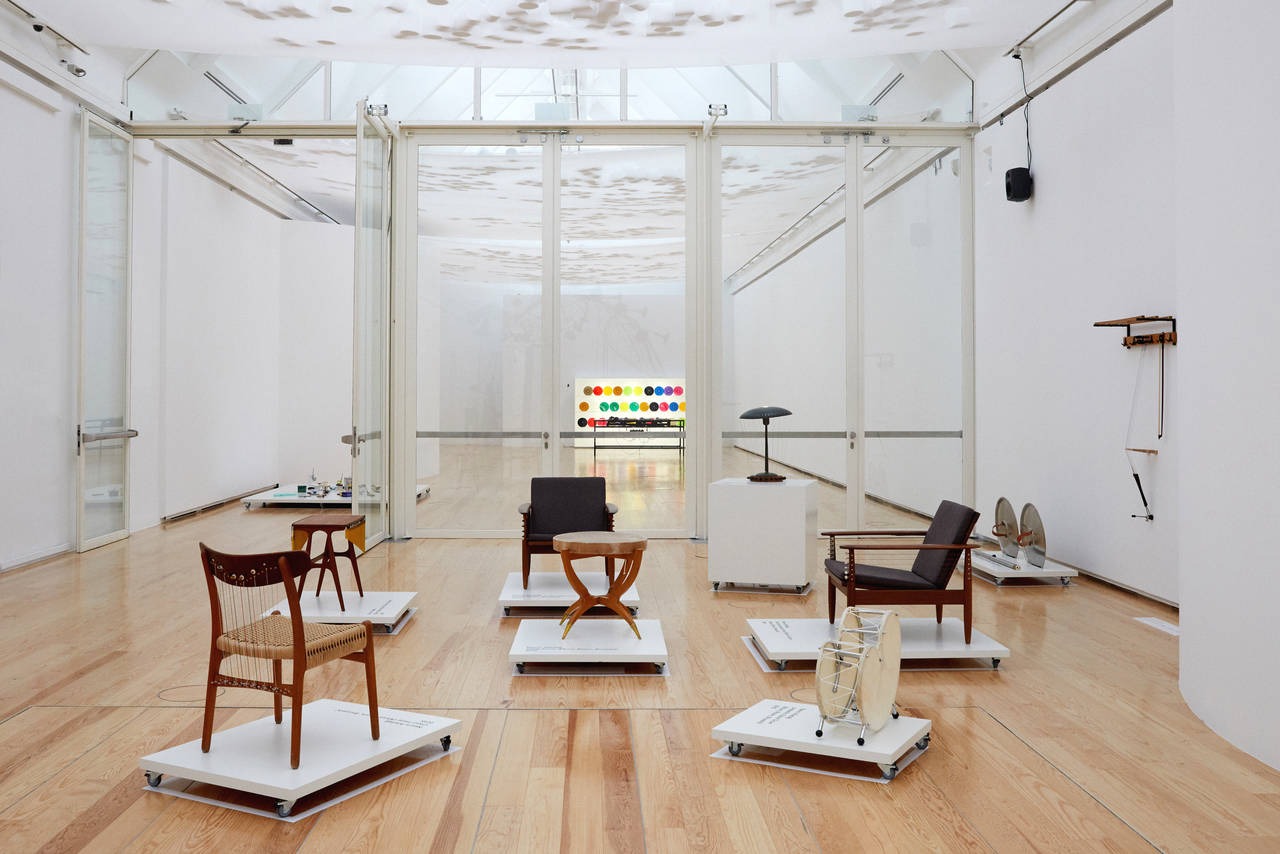Big Orchestra
19 Jun - 08 Sep 2019

Carsten Nicolai, Bausatz Noto ∞ (Color Version), 1998/2015 © Vg Bild-kunst, Bonn 2018, Courtesy Galerie Eigen + Art Leipzig/berlin, Photo: Julija Stankeviciene
BIG ORCHESTRA
The Schirn Presents Art Pieces That Also Function As Musical Instruments
19 June – 8 September 2019
Curator: Matthias Ulrich
ARTISTS
Doug Aitken, Nevin Aladağ, Allora & Calzadilla, Carlos Amorales, Tarek Atoui, Cevdet Erek, Guillermo Galindo, Constantin Luser, Christian Marclay, Caroline Mesquita, Rie Nakajima, Carsten Nicolai, Pedro Reyes, Naama Tsabar, Hans van Koolwijk, David Zink Yi
WALL PANELS OF THE EXHIBITION
The exhibition BIG ORCHESTRA sees itself as an experiment – an experiment with sound, an experiment with the exhibited works of art and an experiment with the exhibition as such. As with any exhibition, there are works of art on show. In this case though they provide an acoustic quality in addition to their visual characteristics. Through collaboration with ambitious and professional musicians, the sculptures become instruments that are made to resound within the exhibition rooms. On mobile platforms, the works of art ultimately achieve ever-new constellations, and thereby also visually determine the respective interactions of the various instruments. The identity, or rather, identities of the exhibition and the exhibited works is thus challenged and resolved in a simple way.
The concept of this exhibition is inspired by the expanded notion of art and music of Fluxus. Fluxus – the avant-garde movement of the 1960s – was a form of action-based art that viewed itself as an alternative to elitist high art. In Fluxus, happenings were frequently called “concerts” since acoustic, choreographic, and musical forms of expression were combined in a collage-like process with their structures ultimately resembling musical compositions. At the first Fluxus festival in Wiesbaden in 1962 for instance, which was organized by one of the co-founders of Fluxus, George Maciunas, Piano Activities, a work by Philip Corner was at the center of the action. The score of this piece demanded nothing more than a slow dismantling of a concert grand piano over several days. Fluxus was furthermore informed by musical concepts of John Cage who, with numerous works of “New Music”, was one of the world's most influential composers and avant-garde artists of the twentieth century. Cage made the remark that “everything we do is music”. BIG ORCHESTRA builds on this idea of a combination of sculpture, music and concert.
The works in BIG ORCHESTRA lead a double life between art and music; they are sculpture or installation and, at the same time, a musical instrument. Speaking of “polyphony” in relation to these works here would be not merely metaphorical: as hybrid objects, they actually represent their position not just spatially, but also acoustically.
As in any orchestra, it is not just about polyphony, but also about playing together. The positions are linked by common themes of contemporary art. Making music as a communicative and social interaction that picks up where other forms of language may fail does indeed manifest itself as a motif in many of the works: Everyday objects are appropriated for music making, new forms of establishing contacts are tried out and translation processes are played through. Making music together – especially in form of improvisation – may lead to a rapprochement of one's own and collective points of view. It is therefore not surprising that quite a number of pieces combine musical play on the works with a negotiation of cultural identity, gender normative roles and socio-political conflicts. Their audibility, in addition to being visually perceived, allows for an even more emphatic presence. Even the objects themselves have been ascribed a voice: they become SCHIRN KUNSTHALLE FRANKFURT, WALL PANELS OF THE EXHIBITION “BIG ORCHESTRA”, JUNE 18, 2019, PAGE 2 OF 13 actors, tell their stories or perform random choreographies, each according to their own particular logic.
BIG ORCHESTRA demonstrates how artists are able to examine and reevaluate the traditional concept of a separation of instrument, score and performance. They oftentimes focus on the performative aspect of music-making, experimenting with different notions regarding play and reception of the works of art. Beyond hearing, our visual sense and the sense of touch are activated as well. At times the shape of the instrument develops from a formal, then again from a functional approach. Improvisation and chance are paramount; scores, if at all existent, are conceptually so closely connected with the instrument and the performance that the boundaries between them become obscured.
The key moment of the exhibition lies in the activation of the artistic works. Musicians from the field of experimental music will present the exhibited instruments in sessions and performances lasting several days. A special cooperation with Frankfurt University of Music and Performing Arts temporarily transforms the Kunsthalle into a university. Composer Orm Finnendahl will ultimately produce “Music for Exhibitions” from all the sounds of the exhibition.
The Schirn Presents Art Pieces That Also Function As Musical Instruments
19 June – 8 September 2019
Curator: Matthias Ulrich
ARTISTS
Doug Aitken, Nevin Aladağ, Allora & Calzadilla, Carlos Amorales, Tarek Atoui, Cevdet Erek, Guillermo Galindo, Constantin Luser, Christian Marclay, Caroline Mesquita, Rie Nakajima, Carsten Nicolai, Pedro Reyes, Naama Tsabar, Hans van Koolwijk, David Zink Yi
WALL PANELS OF THE EXHIBITION
The exhibition BIG ORCHESTRA sees itself as an experiment – an experiment with sound, an experiment with the exhibited works of art and an experiment with the exhibition as such. As with any exhibition, there are works of art on show. In this case though they provide an acoustic quality in addition to their visual characteristics. Through collaboration with ambitious and professional musicians, the sculptures become instruments that are made to resound within the exhibition rooms. On mobile platforms, the works of art ultimately achieve ever-new constellations, and thereby also visually determine the respective interactions of the various instruments. The identity, or rather, identities of the exhibition and the exhibited works is thus challenged and resolved in a simple way.
The concept of this exhibition is inspired by the expanded notion of art and music of Fluxus. Fluxus – the avant-garde movement of the 1960s – was a form of action-based art that viewed itself as an alternative to elitist high art. In Fluxus, happenings were frequently called “concerts” since acoustic, choreographic, and musical forms of expression were combined in a collage-like process with their structures ultimately resembling musical compositions. At the first Fluxus festival in Wiesbaden in 1962 for instance, which was organized by one of the co-founders of Fluxus, George Maciunas, Piano Activities, a work by Philip Corner was at the center of the action. The score of this piece demanded nothing more than a slow dismantling of a concert grand piano over several days. Fluxus was furthermore informed by musical concepts of John Cage who, with numerous works of “New Music”, was one of the world's most influential composers and avant-garde artists of the twentieth century. Cage made the remark that “everything we do is music”. BIG ORCHESTRA builds on this idea of a combination of sculpture, music and concert.
The works in BIG ORCHESTRA lead a double life between art and music; they are sculpture or installation and, at the same time, a musical instrument. Speaking of “polyphony” in relation to these works here would be not merely metaphorical: as hybrid objects, they actually represent their position not just spatially, but also acoustically.
As in any orchestra, it is not just about polyphony, but also about playing together. The positions are linked by common themes of contemporary art. Making music as a communicative and social interaction that picks up where other forms of language may fail does indeed manifest itself as a motif in many of the works: Everyday objects are appropriated for music making, new forms of establishing contacts are tried out and translation processes are played through. Making music together – especially in form of improvisation – may lead to a rapprochement of one's own and collective points of view. It is therefore not surprising that quite a number of pieces combine musical play on the works with a negotiation of cultural identity, gender normative roles and socio-political conflicts. Their audibility, in addition to being visually perceived, allows for an even more emphatic presence. Even the objects themselves have been ascribed a voice: they become SCHIRN KUNSTHALLE FRANKFURT, WALL PANELS OF THE EXHIBITION “BIG ORCHESTRA”, JUNE 18, 2019, PAGE 2 OF 13 actors, tell their stories or perform random choreographies, each according to their own particular logic.
BIG ORCHESTRA demonstrates how artists are able to examine and reevaluate the traditional concept of a separation of instrument, score and performance. They oftentimes focus on the performative aspect of music-making, experimenting with different notions regarding play and reception of the works of art. Beyond hearing, our visual sense and the sense of touch are activated as well. At times the shape of the instrument develops from a formal, then again from a functional approach. Improvisation and chance are paramount; scores, if at all existent, are conceptually so closely connected with the instrument and the performance that the boundaries between them become obscured.
The key moment of the exhibition lies in the activation of the artistic works. Musicians from the field of experimental music will present the exhibited instruments in sessions and performances lasting several days. A special cooperation with Frankfurt University of Music and Performing Arts temporarily transforms the Kunsthalle into a university. Composer Orm Finnendahl will ultimately produce “Music for Exhibitions” from all the sounds of the exhibition.

